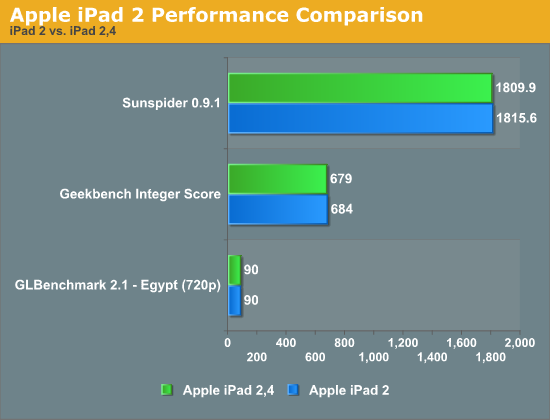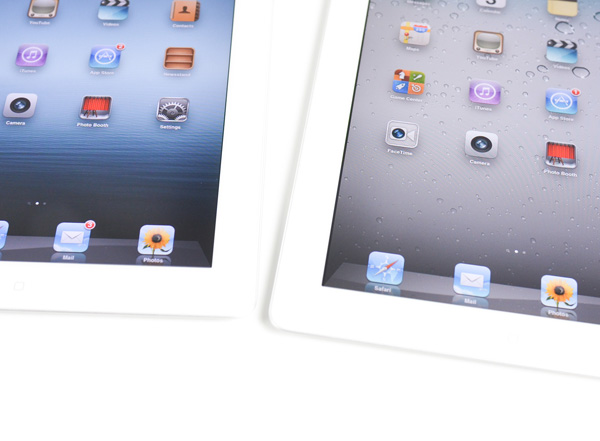The iPad 2,4 Review: 32nm Brings Better Battery Life
by Anand Lal Shimpi on May 4, 2012 12:50 AM ESTDecreased Power Consumption
We obviously know the impact of the new SoC on battery life but here's a look at just how much less power the new platform draws in various conditions. Note that for whatever reason the iPad's power consumption when sitting at the home screen is actually higher than when running our 720p High Profile video playback test. The results were consistent as I tested multiple times across multiple iPads. I have a few thoughts as to what could be happening here:
| Tablet Power Consumption (including Display) | ||||||
| iPad 2,4 | iPad 2 | iPad (3rd generation) | ||||
| Homescreen | 2.7 W | 2.9 W | 6.1 W | |||
| Sunspider | 3.4 W | 4.3 W | 7.6 W | |||
| Moonbat (20 x 4) | 3.9 W | 5.0 W | 8.3 W | |||
| GLBench Egypt (native res) | 3.8 W | 4.5 W | 9.6 W | |||
| GLBench Egypt (offscreen 720p) | 4.1 W | 4.8 W | 10.0 W | |||
| Infinity Blade 2 | 4.3 W | 5.1 W | 10.3 W | |||
| Riptide GP | 3.9 W | 4.7 W | 10.2 W | |||
| Video Playback (720p HP) | 2.2 W | 2.4 W | 4.9 W | |||
Under heavy CPU load (multithreaded Sunspider) we see a 28% increase in power consumption from the 45nm iPad 2,1 compared to the newer 2,4. Keep in mind that we're looking at peak power consumption here, which helps explain the smaller gap on the GPU side than what we saw in our battery life tests. What this data does show however is that the power efficiency improvements can be just as significant for CPU bound workloads, it's simply harder to find workloads that are CPU bound for long periods of time.
Looking at the 3rd generation iPad data reminds us of just how power hungry that platform is. It truly is Apple's performance halo, and it's the perfect target for a 32nm SoC in the future.
The iPad 2 battery life comparison numbers were generated on a lightly used iPad 2 with fewer than 20 charge cycles. While it's possible that some of the differences highlighted on the previous page are due to differences in the batteries between these two devices, it's likely that the variance is in the single digit range at best due to the limited number of charge cycles on the iPad 2 (Update: we confirmed the delta between our iPad 2 results and a brand new, out of box 45nm iPad 2 was < 3%). The power consumption numbers above remove the battery from the equation and help to validate these numbers.
Slightly Improved Thermals
I ran the same temperature test I did for our iPad review: measure maximum surface temperature of the tablet after a 1 hour loop of Infinity Blade 2. The results aren't surprising:
| Thermal Comparison (Max Temperature) | ||||||
| iPad 2,4 | iPad 2 | iPad (3rd generation) | ||||
| Infinity Blade 2 (1 hour) | 33.2˚C | 34.2˚C | 41.9˚C | |||
The iPad 2,4 manages to shave off a degree of surface temperature. It's not really noticeable, but it's there.
Performance
There's no performance difference between the iPad 2,4 and the older iPad 2 models. Regardless of whether you're looking at CPU or GPU performance, the new and older iPad 2s are indistinguishable. Apple definitely embraced the console mentality with this launch.

One difference you will notice between iPads however is variance in the panel vendor and resulting performance. Similar to what we've reported on in the Mac space, Apple likes to get 2 - 3 vendors for most components with very few exceptions (e.g. the CPU/GPU/SoC). We've seen this primarily be an issue with displays and storage devices in Macs, but on the iPad/iPhone side of the fence it can definitely be noticeable as the display plays such a major role in the experience with these devices.
The iPad 2,4 I'm reviewing has noticeably different display characteristics compared to my older iPad 2. My 2,4 sample has a higher maximum brightness (and black level), better grayscale color accuracy, and lower color temperature (more yellow). The new panel isn't any worse than what we've reviewed previously, in fact it's actually slightly better in a number of areas, although some users may be put off by the lower white point temperature (6200K vs. 6600K).
The panel I ended up with here isn't specific to the 2,4, but rather something you could end up with in any iPad 2 model. This is nothing new, but it's always interesting to get an idea of the amount of variance Apple considers acceptable. The new iPad still appears to be in the single or dual source stage (there's conflicting information about whether or not LG made panels are also available today). Sharp is expected to come online in the near future as another source. It remains to be seen how those panels will fare compared to the excellent Samsung panel that Apple launched with however.











100 Comments
View All Comments
Tuvok86 - Friday, May 4, 2012 - link
do you think Apple will introduce the 32nm soc on iPad 3 silently or they will wait for the next iteration?guidryp - Friday, May 4, 2012 - link
"Note that idle power is actually higher than video playback simply because there's more that's being driven on the display, at a higher intensity on the iOS home screen than on a dark 16:9 video."That really doesn't make sense. This is LCD, not OLED. Displaying black/white should take about the same amount of power, because the backlight is uniform and covers the whole display. It doesn't turn off on dark areas of the screen.
Perhaps Apple cheats and turns down the brightness while a movie plays. Create a movie that has a pure white screen and measure nits...
André - Friday, May 4, 2012 - link
No need to call shenanigans. You simply failed to read what was written.It isn't the screen that uses less power but the SoC because it has dedicated hardware for video playback.
guidryp - Friday, May 4, 2012 - link
He is clearly talking about screen content, when he mentions "dark 16:9 video" which implies that power changes drastically dependent on what is displayed.This is true for OLED screens, but untrue for LCD screens.
Also while dedicated Video decode HW offloads work from CPU/GPU, they essentially have no work to offload while idle. Really great dedicated Video decode HW could get you to idle consumption, but I don't see how it could get you below idle.
Something very strange here.
PeteH - Friday, May 4, 2012 - link
What about bandwidth? 8-bit 4:2:0 video is a bit less than 40% of the size of 8-bit ARGB (for equivalent source dimensions).Anand Lal Shimpi - Friday, May 4, 2012 - link
There could be a handful of things happening here:1) It is possible to have a small reduction in LCD power consumption by displaying black vs. white. The gap isn't anywhere near as dramatic as it can be on an OLED display, but it can be measurable. This alone can't explain the difference, I agree.
2) It's possible that Apple is putting the SoC into an even lower power state when a video playback scenario is triggered. Apple does quite a bit of aggressive power management so this wouldn't be too far fetched.
3) It's not clear to me if Apple is doing any localized dimming, which would have a significant impact on video decode power consumption.
Take care,
Anand
guidryp - Friday, May 4, 2012 - link
I think the back-light as the largest power draw (especially in idle), is the easiest source of savings. Displaymate measured 7watts at max for the back-light alone on iPad 3 !Easy reductions either from a simple general brightness reduction when a movie is playing, or dynamic backlight control while a movie is playing. Done right it gets some savings while being hard to notice.
I really don't think you can get a much lower power state while playing video, than while just displaying a start screen. In either case the CPU is still running, still instantly ready for touch, or sensor reactions.
However they did it, it is a slick piece of engineering.
Pshooter - Friday, May 4, 2012 - link
http://www.displaymate.com/iPad_ShootOut_1.htmBSMonitor - Friday, May 4, 2012 - link
"This particular iPad 2,4 sample came from Best Buy, and several attempts to find one elsewhere came up short. All indications seem to point to the iPad 2,4 being relatively rare, which makes sense considering what's inside it."Was one of the other attempts Apple's own website??
Anand Lal Shimpi - Friday, May 4, 2012 - link
The other tries were at an Apple store (3x) and a Walmart (1x).Take care,
Anand